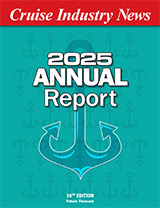The luxury end of the cruise business is under-tonnaged, according to Arthur Rodney, President of Crystal Cruises, who expects that Crystal may have a six-ship fleet by the turn of the century.
Rodney said that industry forecasts of 10 million annual cruise passengers by the year 2,000 showed tremendous growth at the low end of the industry which he said would also result in increased demand for upscale cruises.
Bradford Briggs, Vice President of Sales for Kloster Cruise Limited, was more cautious in his forecasting, saying that he believed the luxury segment has potential for further growth, but that the top end of the market should be very narrowly defined. “Our product is built on history and reputation,” Briggs said, “we cater to discriminating passengers. It is essential to offer all the components right down to the type of clientele as successful people prefer to cruise with other successful people.”
Ronald Santangelo, Senior Vice President, Corporate and Marketing Communications for Cunard Line, said that he saw little growth potential in the luxury end of the market.
Traditional Upscale Market
The traditional upscale cruise segment presently consists of Royal Viking Line’s fleet of four ships, offering 2,870 berths, and Cunard/NAC with two ships and 1,324 berths. With cruises averaging 14 days and more, total annual capacity in this market is presently estimated at less than 100,000 passengers, compared to the 3.5 million Americans that are expected to take a cruise this year, three days or longer.
Until the new Royal Viking Sun was introduced late last year, no new tonnage had been introduced in this market segment for more than 15 years, where supply and demand would have remained totally stagnant had not existing ships been lengthened and new penthouse suites added to others.
Potential Market Development
If the cruise market grows at its predicted annual rate and if the upscale market segment remains proportionally the same, market demand could increase from today’s 100,000 passengers to 300,000.
That would mean an additional 200,000 passengers a year which would enable Crystal to fill seven sister ships to its new 960-passenger Crystal Harmony. Unless Royal Viking Line and Cunard/NAC decide to launch more ships into the market.
Strong growth becomes even more likely in view of the fact that industry executives repeatedly have stated that the market is driven by product, that is, more upscale ships would generate more demand.
Recent CLIA statistics, however, indicate that the market for longer cruises, which tend to equal upscale cruises, has been growing at an average annual rate of only one third that of the market for seven-day and shorter cruises.
Rodney, however, said that the growth would be much stronger based on the high repeat factor at this end of the market; the increasing number of past passengers who will be looking for a more upscale cruise experience; and basic industry growth which will be generated by increased advertising and new tonnage.
Rodney also said that the lack of growth over the last 15 years is not indicative of the future. “In the early days, cruising was new,” he said, “now it is maturing and cruising is more in demand today than it has ever been.”
Conservative Approach
Still, in spite of the market’s tremendous growth potential, and in spite of his expressed optimism, Rodney appears to be proceeding cautiously. Crystal has not yet announced a firm building contract for a second ship much less a fleet. Other start-up cruise lines have traditionally exercised second options even before the first ship has entered service.
“We are committed to grow,” Rodney said, “and our target for a second ship is the end of 1991. There is still plenty of time. I don’t want a second ship any sooner than that, because I want the time to properly absorb it.”
Santangelo meanwhile stressed that while Cunard is committed to the luxury market, it will not be a predominantly luxury line, but will be diversified.
Rodney also emphasized that the success of the Royal Viking Sun had clearly demonstrated that the upscale market will respond to a new product. “The new ship is doing extremely well,” he said, but indicated that this may not be the case for the older vessels in the upscale fleet.
Yacht-like Upscale Niche Struggling
While the several ultra-expensive yacht-like vessels that have been introduced are said to be struggling to generate satisfactory load factors, Rodney noted that both Royal Viking Line and Cunard/NAC have been doing well over the last few years.
According to Kloster Cruise, RVL had load factors of 76.3 percent in 1988 and 86 percent in 1987. The lower load factor in 1988 was attributed to decreased demand in the first quarter following the crash of the stock market in October of 1987. This was partially compensated for, however, by increasing the rates, according to the company’s annual report.
In the meantime, Carnival Cruise Lines, which had promised a decision on its Tiffany project by the end of April, seems to be withdrawing from this end of the market, and has not yet announced a decision on its plans to enter the upscale market.
Market Split
While the traditional ships dominate the upscale market, the yacht-like vessels are carving out a parallel niche as demonstrated by Cunard Sea Goddess and Seabourn Cruise Line. Several newcomers are also said to be planning entry into this market niche.
Rolf Ruud, Vice President of Air/Sea Programs at Seabourn, said that they have strong belief in the growth potential of their market. He said there were many passengers who were impatient with larger ships catering to more of a cross section of the market. “Our passengers want only the best and they want to travel with people sharing their background and interests,” he said.
Ruud said that even if the present market for the very upscale cruises is less than 100,000 passengers, it may effectively be larger since several of these individuals have the opportunity and means to cruise several times a year.
Ruud noted also that little product innovation had taken place until the arrival of the smaller ships and that Cunard and Royal Viking Line instead had added penthouse suites and enlarged their vessels to accommodate their passengers.
Market Changes
While RVL has lengthened their three vessels, said that the 38,000-ton Royal Viking Sun, which accommodates only 740 passengers, is RVL’s commitment to the future, bringing back the traditional definition of luxury cruising.
Rodney said that he foresaw a demand for shorter upscale cruises for those who don’t have the time to sail 14 days and more.
But while Royal Viking Line is experimenting with shorter itineraries, it has also cut its rates which would seem inconsistent with the product niche. The line recently announced its shortest and lowest priced cruises ever in a winter program of 10- and 11-day Caribbean cruises from Fort Lauderdale to Barbados for the Royal Viking Star, which can also be booked in five- and six-day segments.
Rates start as low as $975 for five-day cruises and $1,050 for six days, bringing the lowest per diem below $200.
The radical change from the “normal” RVL program of long and expensive cruises are said to be intended to reach more potential passengers who want to sail with RVL, but don’t have the time to take a long cruise.
Briggs said the the Star’s deployment is an example of RVL’s new and aggressive marketing which is designed to make more cruise passengers familiar with the RVL product. “With its shorter cruises, we’ll carry more passengers on the Star in one year than on the balance of our entire fleet,” Briggs added. “And even though our per diems start at a relatively low end, they will be above any other cruise line in that market.”
Briggs also noted that starting in 1990, RVL will be offering more opportunities for two week cruises which can be combined into longer voyages and will be offered in combination with land packages.
“Our average per diem for an outside cabin with verandah is $368,” Rodney said, adding that he believed that if people wanted the best they would spend an extra $100. He also noted that the line’s new ship, the Crystal Harmony, also offers entry level accommodations at less than $300.
Rodney also said that Crystal had identified a core of some 2,500 travel agents on whom it is focusing its efforts. “I have met with more than 1,000 agents who all wished they had our ship now,” he said. “They all said that the luxury cruise market would benefit from a new product.”
Reported previously in CIN, Kloster Cruise President Trygve Hegnar has indicated that the cruise company has developed design for a fleet of new ships, which would be deployed either by RVL or the company’s mid-market fleet of Norwegian Cruise Line.
Hegnar also said that the new Royal Viking Sun had generated revenues of more than $25 million on her first sailing, a 100-day cruise.
Crystal, which launched its trade campaigns nearly a year ago, will be launching its consumer marketing campaign in August. The 49,000-ton Crystal Harmony is scheduled to enter service in July of 1990.
A realistic Rodney added that if the market prognosis holds, he expects that additional new tonnage will also be introduced by Cunard and RVL and that Carnival will get into the act.



